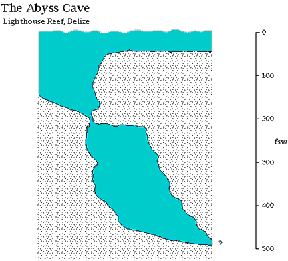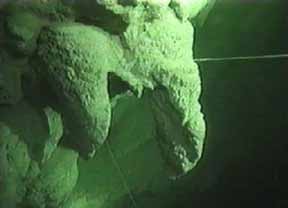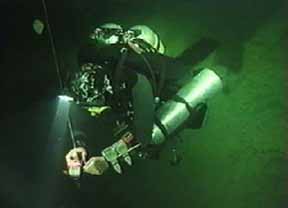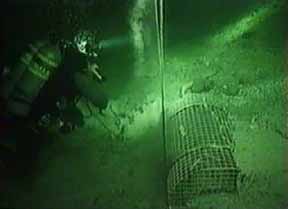
Map of the Abyss cave

We tie off on a stalactite

We enter the cave through the hydrogen sulfide

Matt unclipping the reel

we pass a lost lobster trap on descent

Matt ties off on the bottom
On our previous visit to Belize in November 1995, we’d heard from Frank Bounting, owner of Belize Diving Services on Caye Caulker and an experienced cave diver, that there was a deep submarine cave at the north end of Lighthouse Reef. On that occasion it was logistically impossible to dive it, since we were based 40 miles away on Caye Caulker. It had been fancifully named “The Abyss” after the film of the same name. Frank had dived the cave to a depth of 73 msw (240 fsw) with Andy Stockbridge, the manager of Lighthouse Reef Resort.
The day after we arrived at Lighthouse Reef on the 1997 Cambrian Foundation Blue Hole Expedition, Terrence Tysall, founder of the Foundation and expedition leader, took me to one side.
“Matt and I are diving the south wall of the Blue Hole tomorrow. Would you and Ken [Furman] like to go check out the Abyss? Mike Armstrong can make up a second pair with Andy [Stockbridge] and Tim [Gallagher] can dive in support”.
The entrance of the cave is at 52 msw (170 fsw), formed by a fissure 1.5 metres (5 feet) wide and 6 metres (20 feet) long at the base of an undercut coral-festooned wall. The concave plateau of sand around the entrance forms a shallow basin which funnels sand and other debris towards the fissure. The entrance shaft is clouded by an interface layer of disturbed visibility containing decomposing organic material (a hydrogen sulphide layer or ‘chemocline’).
The plan was that Mike and Andy would wait at the roof of the cave at 67 msw (220 fsw) whilst Ken and I explored further in. To get an indication of the depth we would drop a weighted depth gauge on a line at our turnaround point.
We tied off the line to a spur at the entrance and sank through the hydrogen sulphide layer. The familiar pungent acidic smell of rotting eggs came through our regulators in the misty gloom, then we dropped through a pronounced thermocline into dark clear water.
We had entered an upper corner of the cave; the undercut yellow-white side walls in front of us dropped away beyond reach of the powerful 50W cave lights.
A number of horizontal ledges were visible, dusted with light brown silt. A cluster of three projections under an overhang just below the entrance shaft had clearly once been stalactites, their craggy shapes due to heavy encrustation with marine cement over thousands of years of immersion in sea water.
Ken and I exchanged “OK” signals, then dropped further into the black void. Only the concave near wall was visible, fading into distant blackness on either side. Ahead and below us was nothing but clear empty water, a massive underground room of unknown depth and extent. At 76 msw (250 fsw), I could make out a straight line running vertically past a ledge below us. It was undoubtedly man-made, in a place where nothing man-made had any business being. As we got closer, it appeared to be dark polypropylene rope held up by three white spherical floats on the upper end. Still perplexed, I swam to it. My depth gauge read 91 msw (300 fsw). I could see over the ledge: more black void. This cave goes deep, very deep , I thought. While I clipped off the line reel between two of the floats, Ken dropped the depth gauge. The reel spun furiously as the weighted gauge sank into the darkness beyond our lights.
Time to go. We swam slowly upwards towards Mike and Andys’ lights far above us, Ken reeling in the depth gauge like a subaquatic fisherman. Ascending into the blue glow of the entrance shaft we reached the warmth of the overlying sea water – it was like sliding into a hot bath. We emerged blinking into the daylight, leaving the guideline in situ. We knew we’d be back. As we decompressed above the coral reef, Ken showed me the depth gauge. It read 116 msw (380 fsw).
Bob Dill was very excited about the cave, and in particular the stalactites present at a depth of 71 msw (235 fsw). Matt and Mike dived the cave again early in the next week, discovering more stalactites in the roof and taking a sample of one of the stalactites near the entrance. Despite the heavy encrustation, the core is clearly a calcite spar which can be dated, indicating the geological period in the past when that part of the cave was above sea level.
Our work in the Blue Hole occupied us until our last day of diving, by which time we had enough helium and oxygen left to mount a serious assault on the cave. Terrence put Matt and me together for the exploration team, whilst he and Ken would shoot the all-important video record. The bottom mix (10% oxygen, 60% helium, balance nitrogen) was chosen to keep oxygen partial pressure and inert gas narcosis within safe limits to a depth of 152 msw (500 fsw). Decompression tables were calculated down to this depth using air, 40% nitrox and 100% oxygen as decompression gases.
Once Steve Newman and Tim Gallagher, our very efficient support divers, had staged the all-important decompression gas bottles, we sank through the acid hydrogen sulphide layer into the cold dark water inside the cave
The thin white nylon guideline, knotted every 3 metres (10 feet), led steeply down into the depths. Again the marked thermocline at 60 msw (200 fsw) emphasized the lack of exchange of cave water with the warm sea water above.
We switched to the trimix in our back-mounted doubles at 67 msw (220 fsw) and continued our descent past ledges covered with fine light-brown silt. The water was noticeably turbid compared with the previous week with percolating debris dislodged from the cave ceiling by our bubbles. At about 91 msw (300 fsw) depth Matt circled a small stalactite on the near wall with his light – this was the deepest speleothem found in Lighthouse Reef so far. There was no time to collect it on this dive, nor was there a great desire to. The still unknown depths of the Abyss beckoned us ever deeper.
Just below the stalactite was my reel, left there on the first dive clipped to the float ball line. In the glare of the video lights and with cool dexterity Matt unclipped it, reeled out over the ledge and on, down into unexplored virgin cave.
The excitement of cave exploration is difficult to convey in words; the knowledge that no human being has ever been where you’re going, has ever seen what you’re seeing. More people have been to the moon than the further reaches of this submarine cave.
Down and down we swam, on and on into deep black nothingness, until at last we could see the near wall shelving into a floor beneath us. Ahead of us we could at last make out the far wall angling in towards the floor, which was a shallow debris slope covered with white/yellow sand and silt.
Scattered about were numerous conch shells and, rather incongruously, a lobster trap. We were rather disappointed to find nothing in it.
The floor continued to slope down for another 9 msw (30 fsw) in depth where it almost levelled out, and around us the cave walls and ceiling were dimly visible. On scuba, at a maximum depth of nearly (152 msw) 500 fsw, we had no time for extensive exploration of the bottom.
When Matt had tied off the guideline to a small piece of limestone debris and had handed me back my now nearly-empty reel we turned and swam slowly back up the rippled sandy slope. The deep water was cold, motionless, stagnant. We were the only living things there. How long had the ripples in the sand been there? Hundreds, perhaps thousands of years.
The ascent seemed to last forever. With minute-long deep safety stops at 122 msw (400 fsw) and 91 msw (300 fsw), we rose slowly after our bubbles, which were dislodging a snowstorm of limestone flakes from the fragile ceiling hundreds of feet above us. By the time we reached 91 msw (300 fsw) visibility had dropped to less than 3 metres (10 feet), although this improved considerably as we ascended into the warmer layer of water at about 88 msw (290 fsw). We shone our lights into the murky darkness above, hoping to glimpse the stalactites at 67 msw (220 fsw) where we would switch back to air (carried in a side-mounted stage bottle) and begin our three hours of decompression. At last we were there. The dim blue of the outside world seeped in through the entrance shaft as we started our decompression schedule. We emerged into the warm clear ocean water at 52 msw (170 fsw) to be greeted by our deep support diver Steve, laden with extra bottles of decompression gas. Despite the warmth of the water outside, we were all cold and I for one was shivering violently. The deepest water in the cave was untouched by the sun’s warmth; at 16 degrees centigrade (60 degrees Fahrenheit) it was not especially cold, but the combination of inefficient neoprene wetsuits at such depths and helium’s high thermal conductivity had chilled us and we knew we would be in the water for a further three hours.
That three hours passed uneventfully and we eventually surfaced, triumphant and hungry. We had just explored the deepest underwater cave in Belize and the fourth deepest cave in the country. At 148 msw depth, just behind Cebada Cave in Chiquibul (155 metres) and Actun Zotziha (152 metres) in second and third places, it is still going, and will perhaps take second place in the future.

